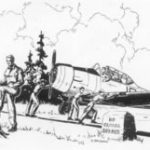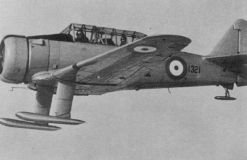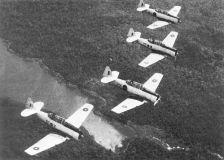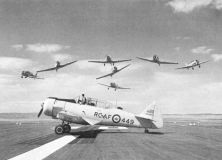Another cracking article by FLIGHT LIEUTENANT J. A. WHITELAW (The Roundel Vol 17, No. 4 May 1965) This article gives a first hand account of how the T6 Harvard was employed throughout the Canadian BCAPT days
The Harvard has been appropriately described as the aircraft which has defied the rules of obsolescence and ignored its own obituaries. But now, after almost 26 years of RCAF service, its days are drawing to a close. There are many serving and ex-RCAF members who will pause and reflect wistfully on past experiences and associations with this time-honoured trainer. Certainly no other aircraft in the history of the RCAF engenders the same nostalgic memories from so many thousands of fliers, from a wide variety of countries who, flew the “yellow peril” during their embryo pilot-days.

The Harvard has been appropriately described as the aircraft which has defied the rules of obsolescence and ignored its own obituaries. But now, after almost 26 years of RCAF service, its days are drawing to a close. There are many serving and ex-RCAF members who will pause and reflect wistfully on past experiences and associations with this time-honoured trainer. Certainly no other aircraft in the history of the RCAF engenders the same nostalgic memories from so many thousands of fliers, from a wide variety of countries who, flew the “yellow peril” during their embryo pilot-days.
Prior to the outbreak of the Second World War the RCAF had ordered 15 Harvard Mk I aircraft from the North American Aviation Company. These trainers were to play a vital role in the planned buildup of the RCAF. They were, in fact, the fore-runners of the vast numbers of training aircraft which were later to support the British Commonwealth Air Training Plan (BCATP). Delivery of the first Mk I Harvard was made to Western Air Command on 19 July 1939. (This original aircraft flew, with minor mishaps, throughout the war but was eventually written off in an accident at No. 1 TTS Aylmer on 9 May ’46.) Ninety additional Harvards were ordered from the USA during 1940. An interesting sidelight occurred during the delivery of these aircraft to Canada. To pre- serve the neutrality of the U.S. after Canada entered the war all Harvards purchased from the U.S. were flown to the international boundary at Coutts, Alberta and other points, and pushed or towed across the border into Canada. In November 1939, an officer of No. 111 Coast Artillery Co-operation Sqn., located at RCAF Stn. Vancouver, proceeded to Coutts to complete arrangements for the acceptance of these aircraft, which were then flown to their Canadian destinations.

With the beginning of the war and the commencement of the BCATP a massive buildup of training facilities took place across Canada. The Harvard was selected to be the prime advanced single-engine trainer and service flying training schools were established across Canada at such places as Camp Borden, Ottawa, Dunnville, Moncton, Summerside, St. Hubert, Kingston, Moose Jaw and Swift Current, to handle the vast influx of trainee pilots answering the call to the colours. In addition to the training of Canadian pilots, the Harvard was utilized to provide air instruction in Canada for pilots from almost every country allied against Germany during the war. RCAF Stn. Trenton, with one of the largest inventories of Harvard, became the home of Central Flying School and later No. 1 Flying Instructors’ School where potential instructors received their training then went on to instruct other Harvard pilots.
In January 1940, 100 Mk II Harvards were ordered from the Noorduyn Company of Canada which was licensed to produce the aircraft in this country. This original Canadian order was increased to 210 aircraft in July of the same year and subsequently increased again, until by the end of the war almost 2,000 Harvards had been supplied by the Noorduyn Company to the RCAF.
The main difference between the Mk I and II aircraft was the change to an all-metal fuselage and squared wing tips. The power plant was the same in each and with the excep- tion of a few minor modifications, the Pratt and Whitney Wasp, rated at 550 Brake Horsepower, is still in use in Harvards today. This engine has established itself as a symbol of continuing reliability, a fact which would be readily confirmed by those who flew the Harvard during their training days and in later years.
As the BCATP gained momentum the familiar throaty roar of the Harvard was heard the length and breadth of the populated areas of this country. Some 11,000 Canadians plus another 8,000 from allied countries received pilot training on the Harvard aircraft in Canada during the war years.
From the training point of view the Harvard was considered to be an excellent investment. With a fairly high wing loading (21.5 lbs per sq. ft.) and consequently a relatively high landing speed, the Harvard required from the pupil something of the same skill he would later require in handling operational aircraft. If was fully aerobatic, not too easily controlled and sufficiently rugged to endure the heavy loadings and rough landings frequently im- posed upon it by student pilots. Serviceability was uniformly high and at no time was there a serious shortage of airframe or engine spares. The record shows that Harvard equipped training schools had much less difficulty in fulfilling their training requirements than was experienced by schools equipped with other aircraft. The chief hazard in flying the Harvard was its undeniable tendency to ground-loop caused apparently by the design of the tail wheel and a high centre of gravity. Modifications to produce a partially steerable tail wheel have since been incorporated but the Harvard still tends to ground-loop unless carefully handled. A stern taskmaster, but a reliable and efficient trainer, the Harvard, because of this ground looping tendency, required the pilot to be constantly alert, particularly during the landing phase.
During 1943 as the BCATP reached its peak output the Harvard kept pace and some were eventually modified as armament trainers capable of carrying machine guns, rockets and practice bombs. Student pilots of that era were thus indoctrinated in the art of offensive warfare prior to their taking operational training on more advanced aircraft.

In the late 1944 as the tide of war turned in favour of the allies, the BCATP was gradually phased-out until it ceased operation completely in 1945. The Harvard, rated as the finest aircraft of its class in the world had trained thousands of pilots, had flown almost four million hours and had played an inestimable part in the winning of the ultimate victory. At this time the future of the Harvard was uncertain. Many stations retained small numbers for practice flying and communications flights but the majority of Harvards on strength at the end of hostilities were placed in long term storage on abandoned airfields across the country. A period of readjustment [had] begun.
RCAF post-war pilot training was commenced on a small scale in 1947. Again the Harvard aircraft was called upon to be the prime basic trainer and in fact an experiment in one stage training was begun to eliminate initial training on an elementary type aircraft. A Harvard training school was established at RCAF Stn. Centralia and the first post-war course of pilot trainees graduated in 1948. In August 1949 Canada joined with 11 other nations in the formation of the North Atlantic Treaty Organization and was committed to provide training facilities for pilots and navigators from NATO countries. The wartime airfields of this country once again reverberated to the distinctive roar of the Harvard aircraft as the RCAF commenced a rapid build up to meet this new requirement. Training schools were established at RCAF Stns. Moose Jaw, Claresholm, Calgary and eventually Penhold, to instruct trainee pilots from Norway, Denmark, Italy, France, West Germany, Portugal, Turkey, Belgium, Holland, and Great Britain. Many former instructors and wartime pilots were recalled to the service to man the re-activated Stations. Once again the sound and sight of the faithful Harvard became a part of the Western Canadian scene.
The Mk IV Harvard was introduced in early 1951. This latest version was of the same basic design as the Mk II but embodied more sophisticated instrumentation and a greater fuel capacity for longer range. A 10 channel VHF set and radio compass installation in the new models was a far cry from the original Gosport Tube, and later electrical intercoms, incorporated in the Mk I and II. Production of the Mk IV was carried out at the Fort William plant of the Canadian Car and Foundry Company where approximately 270 of these aircraft were manufactured. During this same period civilian contracts were let for the overhaul and modification of Mk II Harvards coming out of storage or from time-expired active service. As a note of interest, the Canadian Car and Foundry Company under a license agreement with North American Aviation, manufactured and supplied Harvard spare parts for Canada, Great Britain, Norway, Sweden, Denmark, Holland, Belgium, France, Switzerland, Spain, Portugal, Belgium Congo, Pakistan, Egypt, China and New Zealand. Most of the Harvards held by these countries were manufactured by the Noorduyn Company during the war years and it has been estimated that there are roughly 2000 Harvards still providing useful service around the world.
The concept of using the Harvard as a combination elementary and intermediate trainer was discontinued in early 1953 and a return to the wartime method of having a lighter type aircraft as an elementary trainer was instituted. Student pilots of this period were given approximately 25 hours on the Chipmunk prior to proceeding to the flying training schools for Harvard training, where they received 162 hours of flying before going on to advanced training on the T-33. By 1954 serious consideration was being given to providing the RCAF with a replacement for the ageing Harvard. In line with this, a new intermediate trainer designated the Mentor or T-34, designed and manufactured by the Beech Aircraft Corporation, made its appearance upon the scene. An experimental course of student pilots was processed through normal training at No. 4 FTS Penhold on this aircraft but, for various reasons, the Mentor was not considered acceptable and its use in the RCAF was terminated.
The Harvard meanwhile renewed its lease on life and continued turning out pilots as it had been doing for some 16 years at that point. The requirement for the training of NATO aircrew diminished somewhat after 1955 and by 1960 Stns. Moose Jaw and Penhold were the only remaining Harvard flying schools in the RCAF. By this time several hundred surplus Harvards had been turned over to Crown Assets for disposal, many of which found a ready market among the civilian operators of the country and particularly ex-RCAF pilots. The sound of the Harvard has not been quieted but rather it continues, in civilian markings, to shatter the stillness of many small airfields, from British Columbia to Newfoundland. It has often been asked why a great number of Harvards in the air make no more noise than one Harvard in the air by itself. The answer, presumably, is that there is no more noise in the world than that made by one Harvard, and that it is physically and mathematically impos- sible to multiply infinity. Therefore, when you have heard one Harvard you have heard them all.
During the period 1955-60 work was continuing on the project of obtaining a suitable replacement for the Harvard with a view to instituting all-jet training in the RCAF. In 1959 a new primary jet-trainer, the CL-41, designed and built by Canadair, was ready in prototype. This was the aircraft destined to displace the Harvard; however, it was to be another five years before the CL-41 would be available in sufficient quantity to staff the training schools. In the spring of 1962 a group of instructors at RCAF Stn. Moose Jaw formed a Harvard acrobatic team to perform during Air Force Day at that unit. As a result of this noisy, fast moving display the popularity of the tireless Harvard became immediately evident when Stn. Moose Jaw was flooded with requests to have the “Goldilocks” perform at other Air Force Days and air shows across the country. Before the team was disbanded in 1964 they had demonstrated their prowess, and the versatility of the Harvard, at dozens of air shows including the Canadian International Air Show in Toronto. The “crazy formation” displayed by this group was a sight to be long remembered by spectators and proved to be one of the highlights of the show.

The post-war record of the Harvards’ achievements is impressive. More than 6000 Canadian and NATO student pilots have received training on this aircraft and in addition a number of trainees from the Nigerian Air Force were trained on Harvards at No. 4 FTS Penhold and at FIS Moose Jaw in 1964. Most student pilots undergoing training today were not yet born when the Harvard was making its invaluable contribution to the Allied cause during the Second World War.
There are very few pilots of this present day who have not logged Harvard flying hours at some time during their careers. For those who have not and for those to come who may never have the opportunity to fly this aircraft, one can only say that for them a very real part of the aviation story has been missed.
At RCAF Stn. Penhold the final Harvard course is nearing completion. On 21 May ’65, the last group of Canadian student pilots to fly the Harvard as an RCAF trainer Will graduate and the “Yellow Peril” will have completed another job “well done”. This aircraft, which has established itself as one of the most successful and renowned trainers in the history of flying and has probably trained more pilots than. any other aircraft, will leave behind a record unparalleled in the annals of aviation. There are many who will mourn its retirement from Canadian training and there are, some who will forever stoutly maintain that the Harvard will never be replaced. It will always hold the place of honour it has forged for itself through long and faithful service. When the Har- vard is finally retired it will bring to a close a memorable and splendid era in the history of the RCAF.